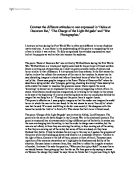Comparing The Powerful Images of the Tyger and the War photographer
William Blake and Carol Ann Duffy both utilize powerful imagery to describe the “War Photographer” and “The Tyger”, making similar statements about them. In addition, both poems use vivid imagery associated with the theme of religion and war.
The use of imagery by both poets emphasizes the parallelism between the “The Tyger” and the “War Photographer” as it suggests that both these characters prey on death. For example, William Blake describes the Tyger to have a “fearful symmetry” and “fire” in its eyes. The words “fearful” and “fire”, create a semantic field of ferocity and danger associated with the Tyger. Furthermore, this highlights the savage and formidable side of the Tyger, making the predatory nature of such an animal prominent. The use of the word “symmetry “ not only indicates the Tiger’s symmetrical appearance but also, on a deeper level may imply the ordered and mechanical manner in which it kills its prey. This is because the fact that its appearance remains symmetrical suggests how emotionless and insensitive it is when using the death of other animals to fuel its own ruthless mind and body. Although the “War Photographer” isn’t portrayed to this extent of barbarity, the fact that he uses death and suffering as a source of income is certainly similar to the Tyger’s situation. This is exemplified when Carol Ann Duffy says that the War Photographer “stares impassively at where he earns a living.” The use of the adverb “impassively” conjures up images showing how the War Photographer is so unemotional and machinelike in the way he takes pictures of the death and suffering of War just to “earn a living.” Therefore, in this way, the mental images formed in reader’s mind from each poem illustrate that the War Photographer is synonymous with the Tyger as they both cold-heartedly use the medium of death to improve their own lives.
However, on other hand, the dichotomy of both the Tyger and the War Photographer is also made clear with the use of imagery. For example, William Blake also depicts the Tyger to be “burning bright.” This emphasizes the magnificence of the Tyger in a much more “bright” and positive manner, juxtaposing its deadly and dangerous side. The use of bilabial plosives in the ‘b’ sounds in “burning” and “bright” creates an explosive and energetic sound, creating images of an animated and vibrant animal, contrasting to the alternative dull and spiritless perception of the Tyger. Moreover, the depiction that the Tyger is a thing of beauty rather than terror is accentuated when the Tyger, which is “burning bright”, comes from “the forests of the night.” This paints a picture of the Tyger being something good coming out of evil as the words “forest” and “night” have connotations of something dark and sinister, contrasting to the magnificence of the Tyger’s brightness. William Blake also goes on to ask the question “Did he who made the Lamb make thee?” This is referring to God as the Lamb is depicted as the ‘Lamb of God’. This question reinforces the idea that there must be something good coming out of this seemingly deadly creature if God is its creator. The reason for this is that God is often pictured an omnipotent, benevolent figure and the fact that he created the “Lamb”, a symbol of complete innocence and purity, reinforces this. Therefore if he created the Tyger, there must be a positive outcome to its invention. Perhaps Blake is conveying the image to the reader that the valuable purpose of the Tyger is to create a natural order of balance in the world. Although on the surface its predatory nature seems only to have negative impacts, it is required to ensure the survival of not only its own species but also to prevent the overpopulation of prey species like the Lamb. This imagery implies that the Tyger needs to prey on animals such as the lamb in order to keep balance in the world, and to allow the circle of life to happen, a concept that is reinforced by the cyclic structure of the poem. Similarly, in War Photographer Carol Ann Duffy mentions how the War photographer “sought approval without words to do what someone must.” This adds a sense of morality to his job and the purpose of it, just like the creation of Tyger benefits the world in a much larger sense; he doesn’t do it just to earn money. This produces a contrasting image on the War Photographer as it suggests he is doing something right and “what someone must” as making people aware of the death and suffering in the world, is a step closer to resolving this problem of war. Furthermore, powerful imagery used by both C. A. Duffy and William Blake, emphasizes the duality of the Tyger and War Photographer. On the surface, both the Tyger and the War photographer seem to be emotionless and insensitive in the way they prey on death but the larger, meaningful purpose of each character is also portrayed.








